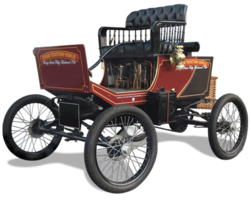Several months ago I mentioned a possible modification to the already Modified Hackworth Valving System that Steam Traction World designed into the Lykamobile. I had a conversation with Ian (of Steam Traction World) about the best practices for timing the engine. In that conversation I mentioned that with the Series 1 and/or the Model Works version of the Lykamobile, that it had been recommended to adjust the position of the reverser about 3/4 of an inch further rearward.
From Model Works Series 1 Memories and Dreams Blog: "The timing of the valves has changed from the original instructions; the original set up gave the car a lot of power in reverse and mediocre power in forward."
Below are a few pictures from his blog showing how it was recommended to time the reverser.
You can see from the above photo the linkages for the valves. The inner linkage is mostly vertical. Also note that the Series 1 connecting rod to the right at an angle passing the brass block is an actual rod welded into an assembly that houses the bearing. This will be an important detail later. The next two photos shows where the linkages were and where they recommended how to fix the timing.
Original Location.
Recommended Location.
For the Series 2 Lykamobile, modifications to the linkages are required to adjust the linkages more rearward. In the Series 2 I believe that the crank counterbalance is a bit larger. Our linkages (adjusted in the vertical position as recommended by Steam Traction World) left no room to move the linkages further towards the crank. The linkages needed to be modified. I discussed this with Ian and he said it was possible that in the future they may provide linkages with a bit of a curvature to allow a better valving set up. So I took it upon myself to try this modification out on my own. Below is one of the linkages where I have ground away material to allow the link to be moved about 1/2 of an inch closer to the engine.

As you can see the link is still very structurally sound. A bit of trial and error was needed to arrive at this curvature. I would place the link back on and see where I needed to grind some more for clearance. This was an iterative exercise. Below is how it looks assembled.


I re-timed the engine valves with the reverser as far rearward to the engine as possible without hitting the counterbalance or brass water pumps. I then test ran the engine under steam with the rear wheels up in the air so the car was stationary to look things over. I discovered that I had a slight knock and after a while I figured out that the connecting rod was banging ever so slightly on the linkages in two places over the crank cycle. That is because our connecting rod was fabricated out of one piece of flat stock steel vs a rod welded together as in Series 1. This necessitated a little more grinding on the red linkage that is attached to the black linkage and a little grinding on the actual connecting rod. Below are the pictures for the connecting rod. Again this was an iterative exercise until I was satisfied that everything had enough clearance.
In this next picture you can see where the red linkage was interfering with the crank and where I removed some material from the crank and red link.
I feel that this modification is helping with the forward power with little to no perceivable difference in reverse. I also believe that the Lykamobile has an easier time starting from standstill to forward motion. It is still possible to further this modification a bit more provided there is room on the brass pumps to remove a little of the corner as shown below. However at this time I am satisfied with this modification and plan not to do any additional modifying of the linkages.






























